Potential for Enhancing Seed Yield and Quality of Spring Oat and Hull-Less Barley Through Intercropping with Pea Under the Pannonian Climate
Abstract
:1. Introduction
2. Materials and Methods
2.1. Climatic Conditions
2.2. Statisitcal Methods
3. Results
3.1. Total Intercropping Yield of Spring Oat and Pea Shows Potential to Align with Yield of Oat Pure Stands
3.2. Seed Quality Parameters Were Higher in Hull-Less Barley than in Oat Intercrops and More Dependent on Yield Fluctuation Under Diverse Cropping Systems
3.3. Association of Yield Components with Yield and Quality Parameters Differed in Hull-Less Barley and Oat Under the Same Agro-Ecological Conditions
4. Discussion
4.1. Spring Oat–Pea Intercropping Sustains Monocrop Oat Yield Under Unfavorable Conditions: Contrasting Associations Between Yield and Yield Components in Oat and Hull-Less Barley
4.2. Seed Quality Traits Were Higher in Hull-Less Barley than in Oat and More Sensitive to Yield Variation Across Cropping Systems
5. Conclusions
- Our results suggest that intercropping can achieve total seed yields comparable to those of oat pure stands, while potentially improving grain quality due to the presence of a legume component in the mixture. A key physiological distinction observed was that, under intercropping, hull-less barley tended to produce fewer but larger and more protein-rich kernels. In contrast, oat prioritized yield maintenance, often at the expense of grain quality.
- The differing responses of hull-less barley and oat to pure stand and intercropping cultivation—particularly in terms of dry yield and grain quality—demonstrate that the behavior of these crops in mixtures cannot be reliably predicted based on their performance in monoculture. This highlights the need for the development of new methodologies and breeding strategies specifically tailored to intercropping systems.
- Varied contributions of specific yield components to oat and hull-less barley yield and quality parameters were observed across growing seasons, suggesting that compensatory growth involving multiple factors should be a focus of future research. In particular, compensatory growth in spring oat and hull-less barley should be further investigated concerning variable seeding ratios and climatic conditions. Additional studies are needed to explore these factors as part of a broader network influencing crop performance under intercropping and environmental stress.
Author Contributions
Funding
Data Availability Statement
Acknowledgments
Conflicts of Interest
References
- Jackson, W.; Piper, J. The necessary marriage between ecology and agriculture. Ecology 1989, 70, 1591–1593. [Google Scholar] [CrossRef]
- Bedoussac, L.; Justes, E.A. Comparison of commonly used indices for evaluating species interactions and intercrop efficiency: Application to durum wheat–winter pea intercrops. Field Crops Res. 2011, 124, 25–36. [Google Scholar] [CrossRef]
- Kirilov, A. Chapter XI—Fodder oats in Europe. In Fodder Oats: A World Overview; Plant Production and Protection Series; FOOD and Agriculture Organization of the United Nations: Rome, Italy, 2004; ISBN 92-5-105243-3. [Google Scholar]
- Stevens, E.J.; Armstrong, K.W.; Bezar, H.J.; Griffin, W.B.; Hampton, J.G. Chapter II—Fodder oats: An overview. In Fodder Oats: A World Overview; Plant Production and Protection Series; Food and Agriculture Organization of the United Nations: Rome, Italy, 2004; ISBN 92-5-105243-3. [Google Scholar]
- Sterna, V.; Jansons, I.; Bleidere, M.; Damskalne, M.; Zute, S. Comparison of hulled and hulless barley composition from pig feeding point of view. J. Int. Sci. Publ. Agric. Food 2021, 9, 123–130. [Google Scholar]
- Ehrenbergerova, J.; Vaculova, K.; Psota, V.; Havlova, P.; Serhantova, V. Effects of cropping system and genotype on variability in important phytonutrients kontent of the barley grain for direct food use. Plant Soil Environ. 2003, 49, 443–450. [Google Scholar] [CrossRef]
- Baik, B.-K.; Ullrich, S.E. Barley for food: Characteristics, improvement, and renewed interest. J. Cereal Sci. 2008, 48, 233–242. [Google Scholar] [CrossRef]
- Wood, P.J. Relationships between solution properties of cereal β-glucans and physiological effects—A Review. Trends Food Sci. Technol. 2004, 15, 313–320. [Google Scholar] [CrossRef]
- Atkinson, F.S.; Brand-Miller, J.C.; Foster-Powell, K.; Buyken, A.E.; Goletzke, J. International tables of glycemic index and glycemic load values 2021: A Systematic Review. Am. J. Clin. Nutr. 2021, 114, 1625–1632. [Google Scholar] [CrossRef]
- Dickin, E.; Steele, K.; Edwards-Jones, G.; Wright, D. Agronomic diversity of naked barley (Hordeum vulgare L.): A potential resource for breeding new food barley for europe. Euphytica 2012, 184, 85–99. [Google Scholar] [CrossRef]
- Jensen, E.S.; Carlsson, G.; Hauggaard-Nielsen, H. Intercropping of grain legumes and cereals improves the use of soil N resources and reduces the requirement for synthetic fertilizer N: A global-scale analysis. Agron. Sustain. Dev. 2020, 40, 5. [Google Scholar] [CrossRef]
- Sirat, A. Determination of yield, yield components, and some quality parameters of bread wheat (hexaploid) cultivars with different origin in arid agricultural conditions. Gesunde Pflanz. 2022, 75, 441–454. [Google Scholar] [CrossRef]
- Sadras, V.O.; Rebetzke, G.J. Plasticity of wheat grain yield is associated with plasticity of ear number. Crop Pasture Sci. 2013, 64, 234–243. [Google Scholar] [CrossRef]
- Sadras, V.O.; Slafer, G.A. Environmental modulation of yield components in cereals: Heritabilities reveal a hierarchy of phenotypic plasticities. Field Crops Res. 2012, 127, 215–224. [Google Scholar] [CrossRef]
- Su, Y.; Yu, R.-P.; Xu, H.-S.; Sun, J.-H.; Zhao, J.; Zhang, W.-P.; Yang, H.; Surigaoge, S.; Callaway, R.; Li, L. Crop cultivar mixtures stabilize productivity, partly via facilitation, when conditions are less benign. Field Crops Res. 2023, 302, 109046. [Google Scholar] [CrossRef]
- Stefan, L.; Colbach, N.; Fossati, D.; Strebel, S.; Häner, L.L. Plasticity in ear density drives complementarity effects and yield benefits in wheat variety mixtures. bioRxiv 2025, bioRxiv:02.25.640070. [Google Scholar]
- Barot, S.; Allard, V.; Cantarel, A.; Enjalbert, J.; Gauffreteau, A.; Goldringer, I.; Lata, J.C.; Le Roux, X.; Niboyet, A.; Porcher, E. Designing mixtures of varieties for multifunctional agriculture with the help of ecology. A Review. Agron. Sustain. Dev. 2017, 37, 13. [Google Scholar] [CrossRef]
- Kopp, E.; Niklaus, P.; Wuest, S. Ecological principles to guide the development of crop variety mixtures. J. Plant Ecol. 2023, 16, rtad017. [Google Scholar] [CrossRef]
- Annicchiarico, P.; Collins, R.P.; De Ron, A.M.; Firmat, C.; Litrico, I.; Hauggaard-Nielsen, H. Chapter Three—Do We Need Specific Breeding for Legume-Based Mixtures? In Advances in Agronomy; Sparks, D.L., Ed.; Academic Press: Cambridge, MA, USA, 2019; Volume 157, pp. 141–215. ISBN 0065-2113. [Google Scholar]
- Timaeus, J.; Weedon, O.D.; Finckh, M.R. Harnessing the potential of wheat-pea species mixtures: Evaluation of multifunctional performance and wheat diversity. Front. Plant Sci. 2022, 13, 846237. [Google Scholar] [CrossRef]
- Sadras, V.O. Evolutionary aspects of the trade-off between seed size and number in crops. Field Crops Res. 2007, 100, 125–138. [Google Scholar] [CrossRef]
- Dwivedi, S.L.; Reynolds, M.P.; Ortiz, R. Mitigating tradeoffs in plant breeding. iScience 2021, 24, 102965. [Google Scholar] [CrossRef]
- Xie, Q.; Sparkes, D.L. Dissecting the trade-off of grain number and size in wheat. Planta 2021, 254, 3. [Google Scholar] [CrossRef]
- Hauggaard-Nielsen, H.; Gooding, M.; Ambus, P.; Corre-Hellou, G.; Crozat, Y.; Dahlmann, C.; Dibet, A.; von Fragstein, P.; Pristeri, A.; Monti, M.; et al. Pea–barley intercropping for efficient symbiotic N2-fixation, soil N acquisition and use of other nutrients in european organic cropping systems. Field Crops Res. 2009, 113, 64–71. [Google Scholar] [CrossRef]
- Li, C.; He, X.; Zhu, S.; Zhou, H.; Wang, Y.; Li, Y.; Yang, J.; Fan, J.; Yang, J.; Wang, G.; et al. Crop diversity for yield increase. PLoS ONE 2009, 4, e8049. [Google Scholar] [CrossRef] [PubMed]
- Browne, R.; White, E.; Burke, J. Responses of developmental yield formation processes in oats to variety, nitrogen, seed rate and plant growth regulator and their relationship to quality. J. Agric. Sci. 2006, 144, 533–545. [Google Scholar] [CrossRef]
- Jevtić, R.; Župunski, V.; Grčak, M.; Živančev, D.; Knežević, D. Cereal–pea intercropping reveals variability in the relationships among yield, quality parameters, and obligate pathogens infection in wheat, rye, oat, and triticale, in a temperate environment. Plants 2023, 12, 2067. [Google Scholar] [CrossRef]
- Thomason, W.; Brooks, W.; Griffey, C.; Vaughn, M. Hulless barley seeding rate effects on grain yield and yield components. Crop Sci. 2009, 49, 342–346. [Google Scholar] [CrossRef]
- Balouchi, H.; Sarvestani, T.; Modarres-Sanavy, S.A.M. Agronomic factors on selected hulless barley genotypes. J. Agron. 2005, 4, 333–339. [Google Scholar] [CrossRef]
- Vicentin, L.; Canales, J.; Calderini, D.F. The trade-off between grain weight and grain number in wheat is explained by the overlapping of the key phases determining these major yield components. Front. Plant Sci. 2024, 15, 1380429. [Google Scholar] [CrossRef]
- Ju, Z.; Liu, K.; Zhao, G.; Ma, X.; Jia, Z. Nitrogen fertilizer and sowing density affect flag leaf photosynthetic characteristics, grain yield, and yield components of oat in a semiarid region of northwest china. Agronomy 2022, 12, 2108. [Google Scholar] [CrossRef]
- Jensen, E.S. Barley uptake of N deposited in the rhizosphere of associated field pea. Soil Biol. Biochem. 1996, 28, 159–168. [Google Scholar] [CrossRef]
- Xiao, Y.; Li, L.; Zhang, F. Effect of root contact on interspecific competition and N transfer between wheat and fababean using direct and indirect 15N techniques. Plant Soil 2004, 262, 45–54. [Google Scholar] [CrossRef]
- Zhao, Y.; Liu, X.; Tong, C.; Wu, Y. Effect of root interaction on nodulation and nitrogen fixation ability of alfalfa in the simulated alfalfa/triticale intercropping in pots. Sci. Rep. 2020, 10, 4269. [Google Scholar] [CrossRef]
- Jensen, E.S. Grain yield, symbiotic N2 fixation and interspecific competition for inorganic N in pea-barley intercrops. Plant Soil 1996, 182, 25–38. [Google Scholar] [CrossRef]
- Neugschwandtner, R.; Kaul, H.-P. Sowing ratio and N fertilization affect yield and yield components of oat and pea in intercrops. Field Crops Res. 2014, 155, 159–163. [Google Scholar] [CrossRef]
- Sugár, E.; Berzsenyi, Z.; Árendás, T.; Bónis, P. Effect of nitrogen fertilization and genotype on the yield and yield components of winter wheat. Die Bodenkult. J. Land Manag. Food Environ. 2016, 67, 25–34. [Google Scholar] [CrossRef]
- Protic, R.; Jovin, P.; Protic, N.; Jankovic, S.; Jovanovic, Ž. Mass of 1,000 grains in several winter wheat genotypes, at different dates of sowing and rates of nitrogen fertilizer. Rom. Agric. Res. 2007, 24, 39–42. [Google Scholar]
- Xu, K.; Chai, Q.; Hu, F.; Fan, Z.; Yin, W. N-Fertilizer postponing application improves dry matter translocation and increases system productivity of wheat/maize intercropping. Sci. Rep. 2021, 11, 22825. [Google Scholar] [CrossRef]
- Simón, M.R.; Fleitas, M.C.; Castro, A.C.; Schierenbeck, M. How foliar fungal diseases affect nitrogen dynamics, milling, and end-use quality of wheat. Front. Plant Sci. 2020, 11, 569401. [Google Scholar] [CrossRef]
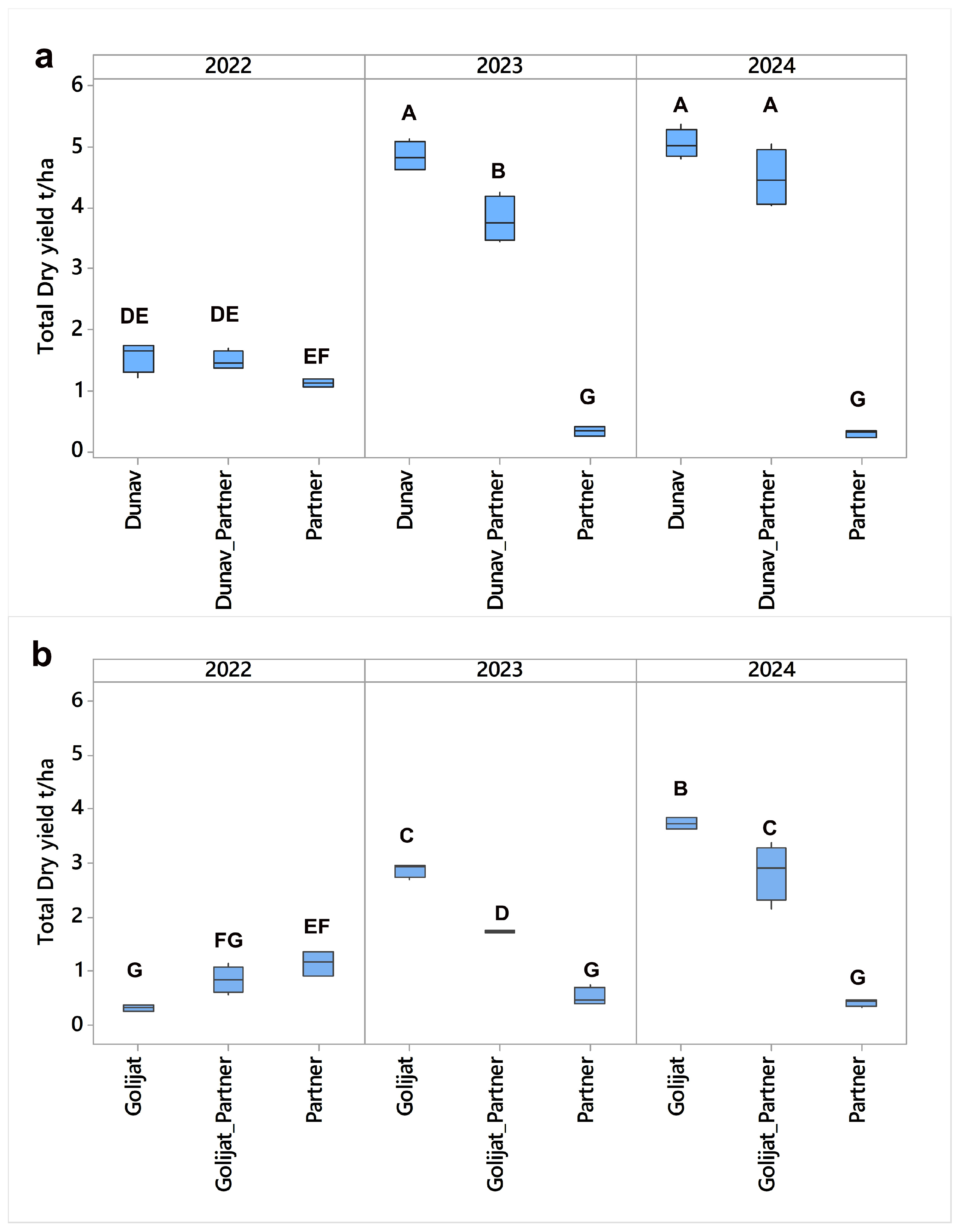
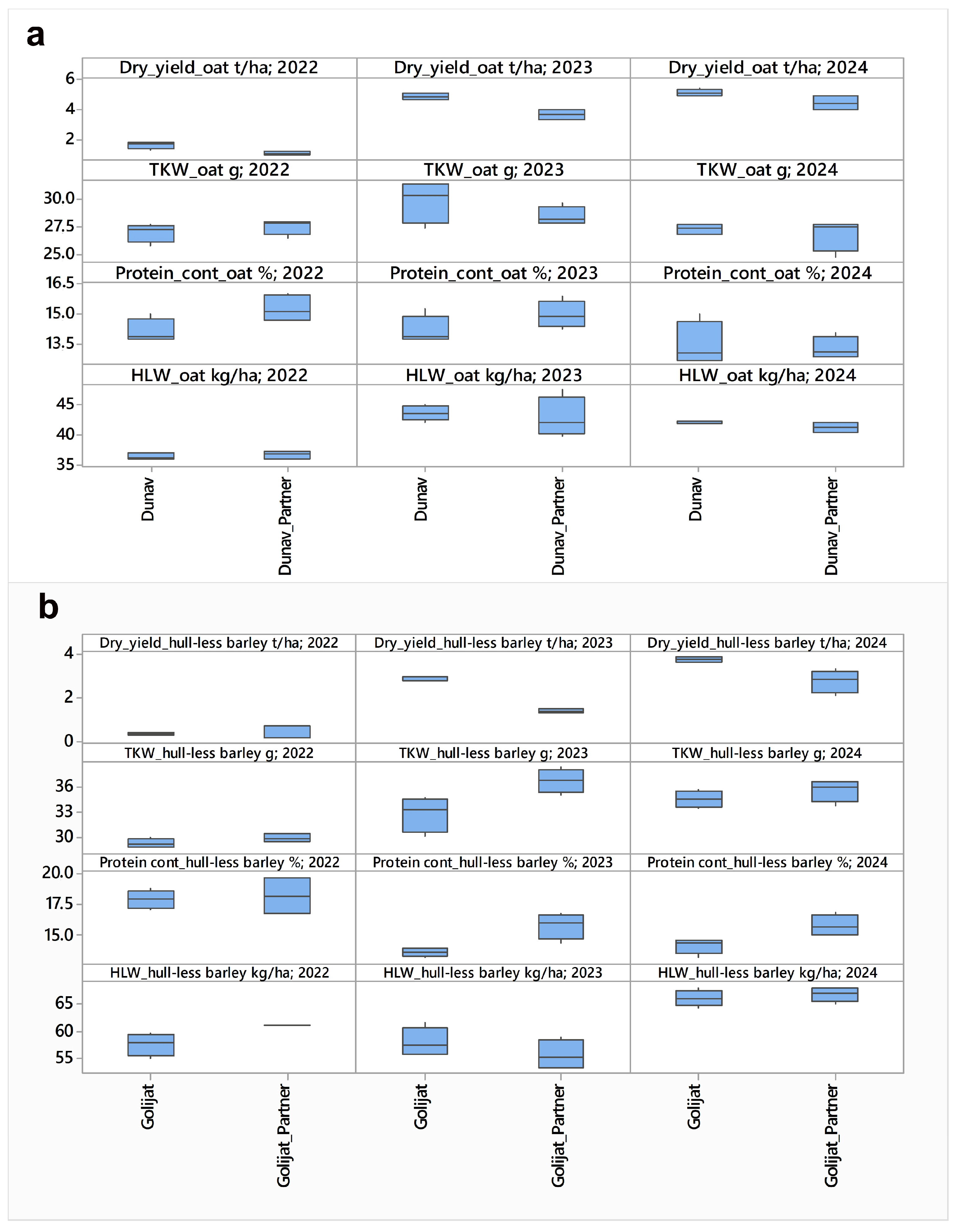
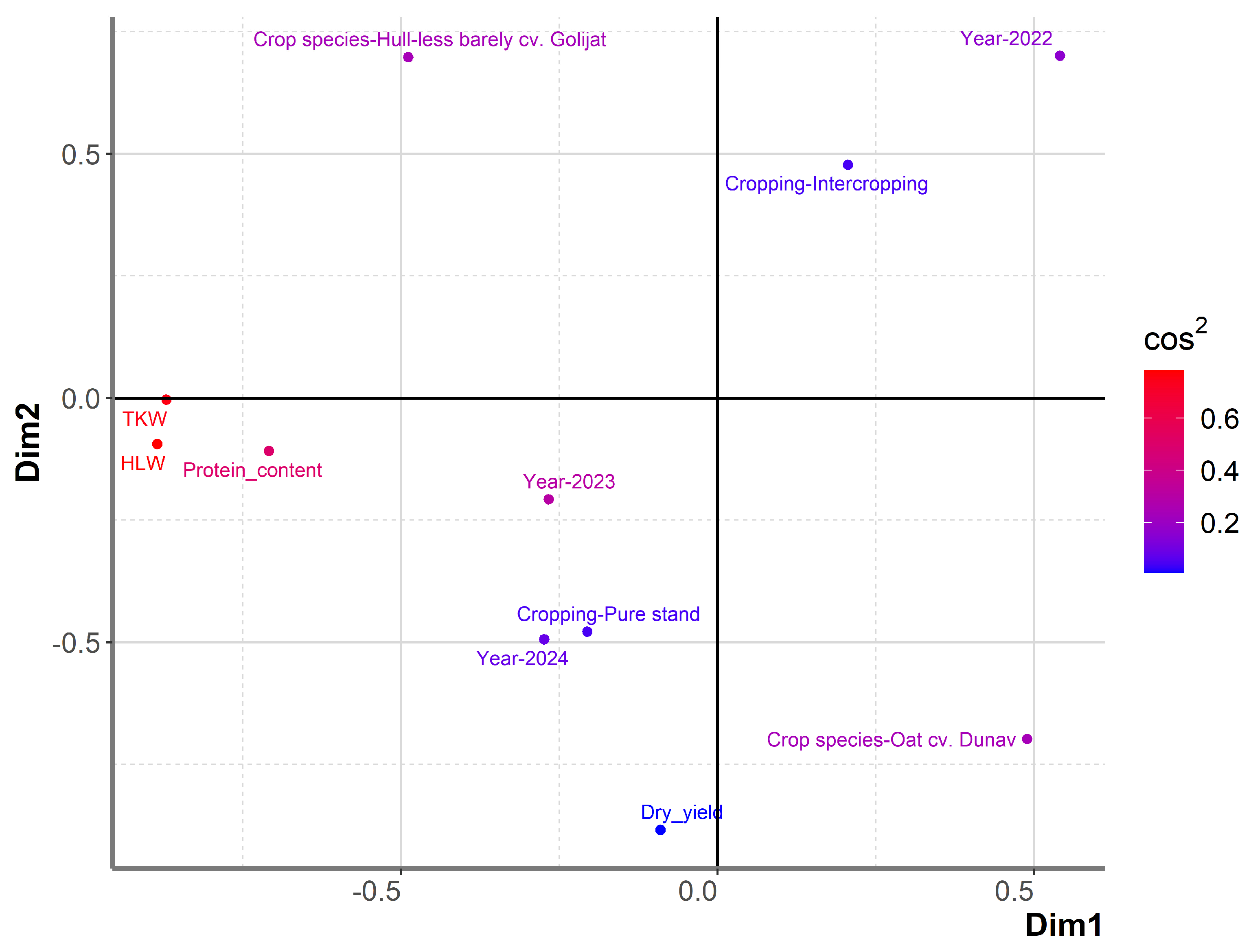
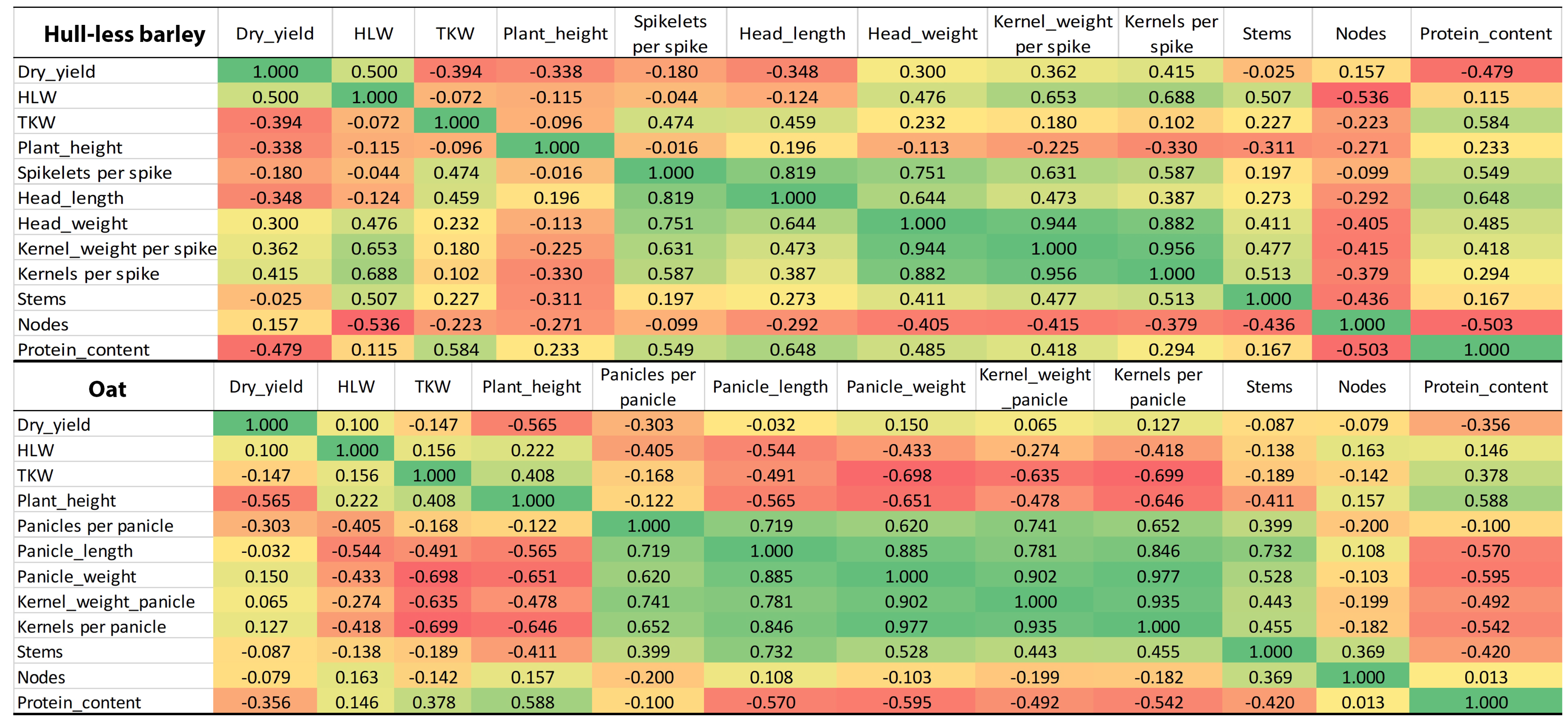

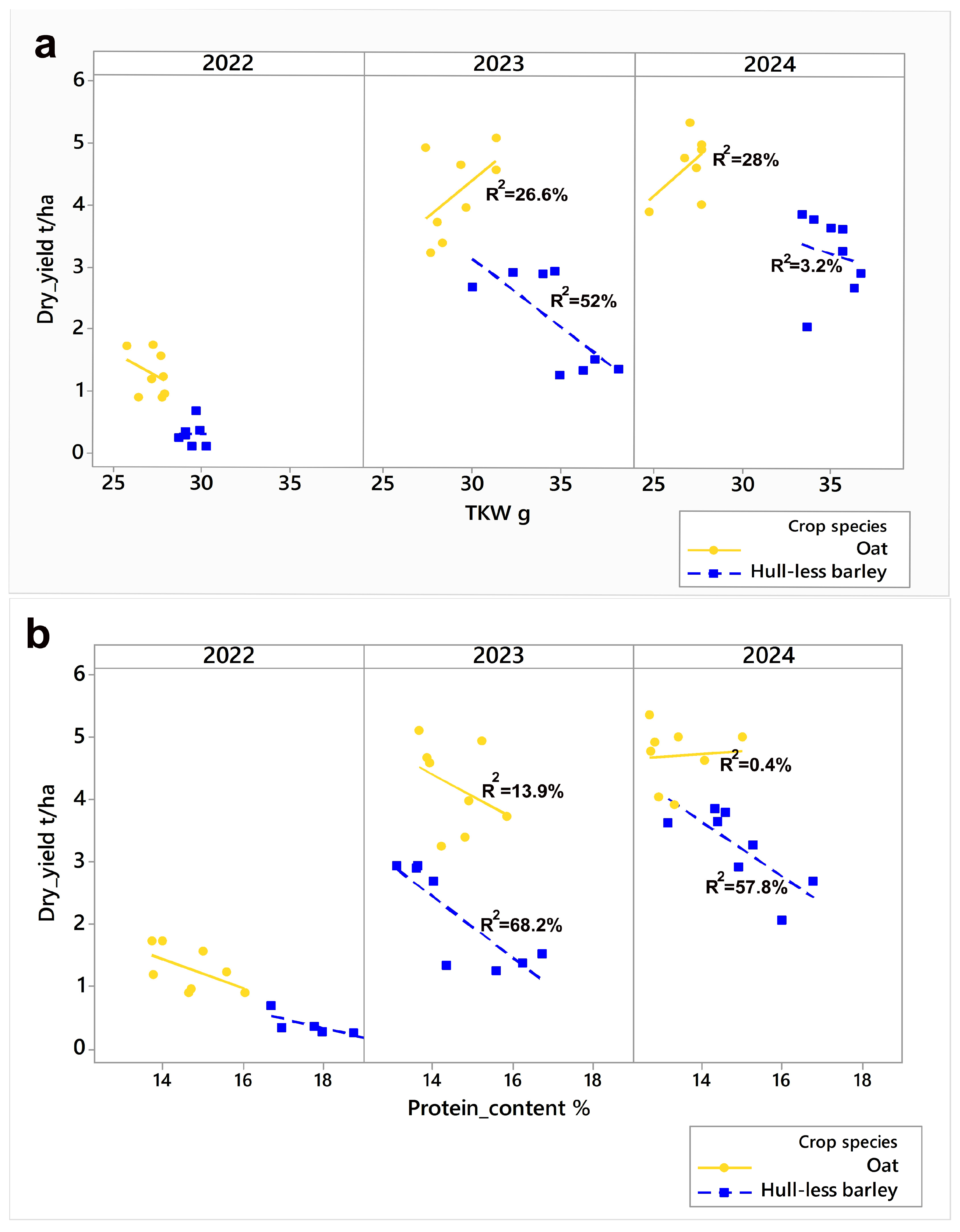
| Year | T Feb. °C | Prec. Feb. mm | T March °C | Prec. March mm | T April °C | Prec. April mm | T May °C | Prec. May mm |
|---|---|---|---|---|---|---|---|---|
| 2022 | 5.7 | 23.7 | 5.6 | 1.1 | 10.9 | 54.5 | 19.2 | 17.9 |
| 2023 | 3.6 | 57.2 | 9.0 | 25.3 | 10.4 | 63.9 | 17.2 | 124.8 |
| 2024 | 9.8 | 9 | 11.2 | 16 | 15.5 | 21.7 | 18.9 | 79 |
| Average 2006–2023 | 3.3 | 44.1 | 7.4 | 43.0 | 12.8 | 43.5 | 17.3 | 91.0 |
| Variety | Cultivation Practice | Dry Yield Cereal t/ha | Total Dry Yield t/ha | Variety | Cultivation Practice | Dry Yield Pea t/ha | ||||||
|---|---|---|---|---|---|---|---|---|---|---|---|---|
| 2022 | 2023 | 2024 | 2022 | 2023 | 2024 | 2022 | 2023 | 2024 | ||||
| Dunav (oat) | Pure stand | 1.7 | 4.8 | 5.0 | Partner (pea) | Pure stand | 1.1 | 0.4 | 0.4 | |||
| Intercropping with Partner | 0.9 | 3.6 | 4.4 | 1.5 | 3.8 | 4.5 | Intercropping with Dunav | 0.5 | 0.2 | 0.1 | ||
| Golijat (hull-less barley) | Pure stand | 0.3 | 2.9 | 3.7 | ||||||||
| Intercropping with Partner | 0.3 | 1.4 | 2.7 | 0.9 | 1.8 | 2.8 | Intercropping with Golijat | 0.6 | 0.4 | 0.1 | ||
| p | p | p | ||||||||||
| GLM | Year | ˂0.001 | ˂0.001 | ˂0.001 | ||||||||
| Cropping system | ˂0.001 | ˂0.001 | ˂0.001 | |||||||||
| Year × Cropping System | ˂0.001 | ˂0.001 | =0.002 | |||||||||
| Variety | Cultivation Practice | TKW g | Crude Protein % | HLW kg/ha | |||||||||
|---|---|---|---|---|---|---|---|---|---|---|---|---|---|
| 2022 | 2023 | 2024 | Aver. | 2022 | 2023 | 2024 | Aver. | 2022 | 2023 | 2024 | Aver. | ||
| Dunav (oat) | Pure Stand | 26.9 D | 29.8 CD | 27.3 D | 28 | 14.1 CD | 14.2 CD | 13.5 D | 14.0 | 36.4 D | 43.6 C | 42.1 C | 40.7 |
| Intercropping with Partner | 27.5 D | 28.4 D | 26.8 D | 27.6 | 15.3 CD | 14.9 CD | 13.3 D | 14.5 | 36.8 D | 42.9 C | 41.3 CD | 40.3 | |
| Golijat (hull-less barley) | Pure Stand | 29.2 D | 32.8 BC | 34.5 AB | 32.2 | 17.9 AB | 13.6 D | 14.1 CD | 15.2 | 57.6 B | 57.9 B | 66.1 A | 60.5 |
| Intercropping with Partner | 29.8 CD | 36.7 A | 35.6 AB | 34.0 | 18.2 A | 15.7 BC | 15.7 BC | 16.5 | 61.2 AB | 55.7 B | 66.8 A | 61.2 | |
| p | p | p | |||||||||||
| Year | ˂0.001 | ˂0.001 | ˂0.001 | ||||||||||
| GLM | Crop Species | ˂0.001 | ˂0.001 | ˂0.001 | |||||||||
| Cultivation Practice | 0.054 | ˂0.001 | 0.904 | ||||||||||
| Year × Crop Species | ˂0.001 | ˂0.001 | ˂0.001 | ||||||||||
| Year × Cultivation Practice | ˂0.001 | ˂0.001 | 0.151 | ||||||||||
| Year × Crop Species × Cultivation Practice | 0.015 | 0.088 | ns | ||||||||||
| Variety | Cultivation Practice | Number of Spikelets per Spike or Panicles per Panicle | Head Length | Head Weight | Kernel Weight per Head | Number of Kernels per Spike/Panicle | |||||
|---|---|---|---|---|---|---|---|---|---|---|---|
| 2023 | 2024 | 2023 | 2024 | 2023 | 2024 | 2023 | 2024 | 2023 | 2024 | ||
| Golijat (hull-less barley) | Pure Stand | 17.2 D | 20.8 CD | 7.6 C | 8.0 C | 0.5 C | 0.9 BC | 0.3 C | 0.7 BC | 11.4 D | 19.9 CD |
| Intercropping with Partner | 22.7 CD | 22.2 CD | 9.6 C | 9.5 C | 0.7 C | 0.9 BC | 0.5 C | 0.8 BC | 14.0 D | 21 CD | |
| Dunav (oat) | Pure Stand | 29.4 BC | 34.8 AB | 14.2 B | 16.1 AB | 1.0 BC | 2.0 A | 0.8 BC | 1.3 A | 28.1 BC | 53.9 A |
| Intercropping with Partner | 39.1 AB | 40.1 A | 15.5 AB | 17.8 A | 1.3 B | 2.5 A | 1.0 AB | 1.5 A | 37.9 B | 61.1 A | |
Disclaimer/Publisher’s Note: The statements, opinions and data contained in all publications are solely those of the individual author(s) and contributor(s) and not of MDPI and/or the editor(s). MDPI and/or the editor(s) disclaim responsibility for any injury to people or property resulting from any ideas, methods, instructions or products referred to in the content. |
© 2025 by the authors. Licensee MDPI, Basel, Switzerland. This article is an open access article distributed under the terms and conditions of the Creative Commons Attribution (CC BY) license (https://creativecommons.org/licenses/by/4.0/).
Share and Cite
Jevtić, R.; Župunski, V.; Brbaklić, L.; Živančev, D.; Dolapčev Rakić, A.; Aćin, V.; Mikić, S.; Orbović, B. Potential for Enhancing Seed Yield and Quality of Spring Oat and Hull-Less Barley Through Intercropping with Pea Under the Pannonian Climate. Agronomy 2025, 15, 1349. https://doi.org/10.3390/agronomy15061349
Jevtić R, Župunski V, Brbaklić L, Živančev D, Dolapčev Rakić A, Aćin V, Mikić S, Orbović B. Potential for Enhancing Seed Yield and Quality of Spring Oat and Hull-Less Barley Through Intercropping with Pea Under the Pannonian Climate. Agronomy. 2025; 15(6):1349. https://doi.org/10.3390/agronomy15061349
Chicago/Turabian StyleJevtić, Radivoje, Vesna Župunski, Ljiljana Brbaklić, Dragan Živančev, Anja Dolapčev Rakić, Vladimir Aćin, Sanja Mikić, and Branka Orbović. 2025. "Potential for Enhancing Seed Yield and Quality of Spring Oat and Hull-Less Barley Through Intercropping with Pea Under the Pannonian Climate" Agronomy 15, no. 6: 1349. https://doi.org/10.3390/agronomy15061349
APA StyleJevtić, R., Župunski, V., Brbaklić, L., Živančev, D., Dolapčev Rakić, A., Aćin, V., Mikić, S., & Orbović, B. (2025). Potential for Enhancing Seed Yield and Quality of Spring Oat and Hull-Less Barley Through Intercropping with Pea Under the Pannonian Climate. Agronomy, 15(6), 1349. https://doi.org/10.3390/agronomy15061349








